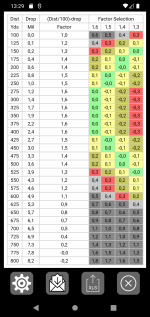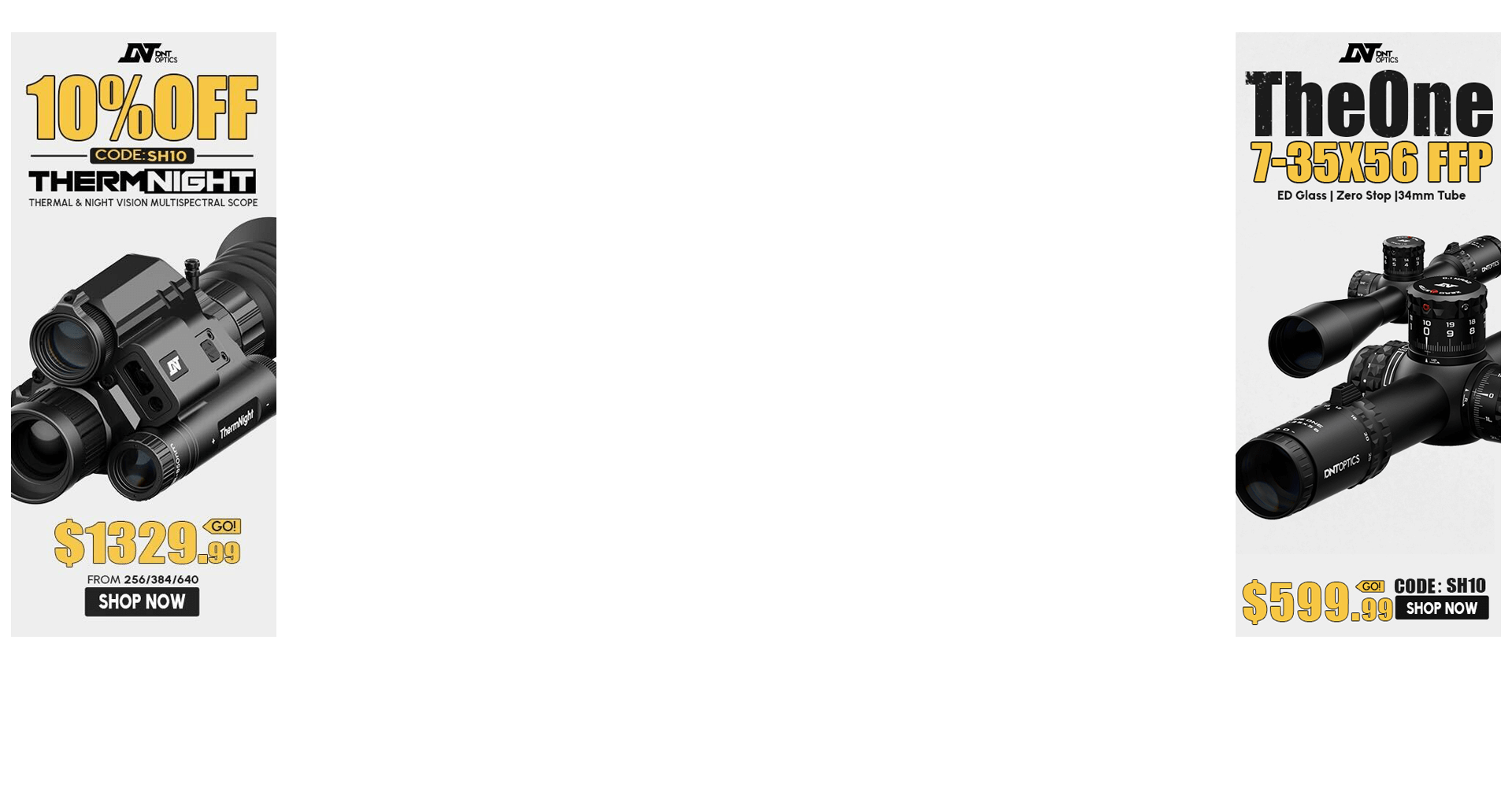By: Ted Hoeger (Jack Master)
How long does it take to find our drop data for a target range? If we need data quickly, most shooters are using some type of paper chart. This chart could be taped to the stock, on a data holder, or arm bar where with a quick glance we can read our data. What if there is a faster way? Welcome to the Speed Drop Factor. Finding and using your Speed Drop Factor will allow you to memorize your drop data to a reasonable distance by remembering one number.
Most rifle calibers have a portion of their bullet flight where the relationship between the drop of the bullet and distance traveled is consistent. A zone where every 100yds of distance is an additional 1mil of elevation. As an example, if our data says 500yds = ~2.5mils, 600 = ~3.5mils, and 700 = ~4.5 mils we can start to see this consistent relationship between distance and come-up. For every 100 yards traveled the come-up is changing 1 mil. As the bullet gets further away and starts to slow down more quickly, this relationship will start to change and will no longer be a constant value, but in the ranges that it works we can use it to our advantage to quickly calculate our come-up.
Before we get too far, let’s understand a couple of limitations for using a Speed Drop Factor.
- We must be using a Mil Scope. This does not work in MOA.
- Speed drop will only work for a specific range for your rifle, caliber and bullet. We’ll find that range in the steps below.
- Some error in the final drop data is expected but we can choose how much error we allow. This is not a perfect system, but it is reliable if we understand the errors we have allowed.
To find our Speed Drop Factor we need to write out our drop data and do some simple math. Start by writing out the drop data for each 25-yard increment from 100 to 1000 yards (or more if your caliber is capable). For each yardage, divide the yardage by 100 and subtract your come-up. [500 yards is (500yds/100) – 2.5mils = 2.5 factor]. Do this for each yardage and start to look for the constancy in this factor. Below is the excel table I used for my 6.5 Creedmoor with 130 ELDs.
Now that we have the Drop Factor for each yardage, we need to choose which factor works the best for our application over a large range of distances. The Prime factor is the highest factor. In the example below, 2.6 at 600yds is the prime factor. 2.6 is the highest and the center number of the highest. We also must choose how much error we want in the Speed Drop Factor. For each 0.1 under the prime factor (2.5 rather than 2.6), we add 0.1mil error into our firing solution. The more error we allow, the wider range the factor is usable; the less error we allow, the less range the factor is used.
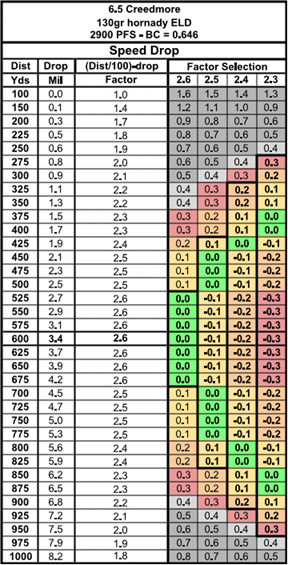
In this example, if we choose to allow zero error the drop scale factor would be 2.6 (the prime factor) and works from 525yds to 675yds. A drop scale factor of 2.3 will allow 0.3mil error high or low and works from 275yds to 950yds.
The more error we allow in the drop scale factor the more error we will have at the edges of the usable distance, and the center of the usable distance. At a factor of 2.3 we can see there is 0.3mil error (high) at 275yds and 950yds as well as 0.3mil (low) from 525yds to 675yds. Depending on your application and caliber you can choose what drop scale factor works the best for you and what ranges you want to use it at.
For this rifle, I chose a factor of 2.5 to allow for a 0.1 mil error, but I also use this factor from 350yds to 900yds. This gives an error of 0.1mil in the center of the range and up to 0.3 mils at the edges of the range, or about 1MOA. Plus, 2.5 is easy to remember and easy to use in the field.
Steps to find your Speed Drop Factor
- Write out the drop data from 100 to 1000+yds by 25yd increments.
- Calculate the Speed Drop Factor at each yardage. Divide the yardage by 100 and subtract your come-up. [500 yards is (500yds/100) – 2.5mils = 2.5 factor]
- Find the highest Speed Drop Factor (choose the yardage in the middle of the highest factors)
- Choose how much error you will allow at the prime factor. (0.1, 0.2, 0.3, 0.4)
- Subtract the allowable error from the prime factor to get your Speed Drop Factor.
- Subtract the error you allowed from your Speed Drop Factor to find the shortest and longest range your Speed Drop Factor will work.
Speed Drop Factor can also be calculated with a 5700 Elite Kestrel. You’ll first need to turn on the Accuracy First ability to find the settings and calculate the factor.
How do we use this Speed Drop Factor?
There are 3 ways we can use the Speed Drop Factor. The first method is mental math, the second is a BDC reticle and the third is a BCD Turret.
Mental Math
This is doing quick math in our head to get our drop data. Once we range a target, we quickly divide it by 100 and subtract my Speed Drop Factor.
Range = 660 → 6.6 – 2.5 factor = 4.1mils.
Range = 515 → 5.1 – 2.5 factor = 2.6mils
To avoid doing math on the clock or in the field we can dial up to the yardage and then dial back down the Speed Drop Factor. I find this simpler and faster if I am stressed. For a 720yd target I would dial up to 7.2mils, then back 2mils (5.2) then back another 0.5mils (4.7mils) for my 2.5 factor. This is how my brain likes to do it, you’ll have to find the way your brain likes to do it.
This is the method I use the most. It’s a quick check whenever I need it. At a match, right before a stage starts, I can ask the range to target and double-check my turret, or when at the range and missing targets I can ask for the target distance and double-check my turret.
BDC Reticle
If your scope is capable of dialing under your zero mark or you can set your zero stop lower, you can dial your scope DOWN your drop scale factor. In my example, I would dial my 10mil per revolution turret down to 7.5 which is 2.5mils below my 100yd zero. Doing this makes the reticle a BDC reticle for the ranges where the drop scale factor works. If a target is at 575 yards, we can hold over 5.7mils. A target that is 800yds is an 8mil holdover. This works for the entire range where the drop scale factor is used.
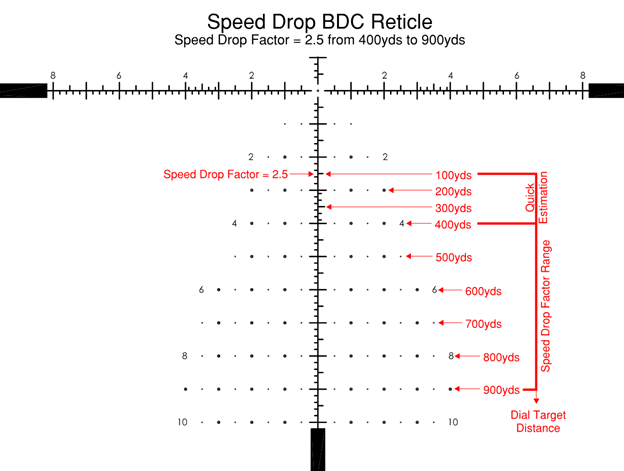
BDC Turret
For this application, we slip our 100yd zeroed turret to the Drop Scale Factor. When we range a target, we will dial the target distance with the turret and use the main cross-hair in the reticle (no Holdover). My rifle when zeroed at 100yds will show 2.5mil on the turret because my drop scale factor is 2.5. For a 575yds target, I dial to 5.7mils and use the main crosshair. For 800yds I dial 8mils on the turret and use the main crosshairs. The benefit of this system is getting to use the main stadia line with the best wind holding capabilities as well as more precise dialing and aiming rather than holding over. The downfall to this system is we need to remember our turret is slipped to 2.5mils (setting a zero stop really helps). Our ballistic program can easily be changed if we add a 2.5mil vertical zero offset. This will add 2.5mils to all our data so we can still dial for targets outside the range of the Speed Drop Factor. We could even rewrite our armbar for this offset.
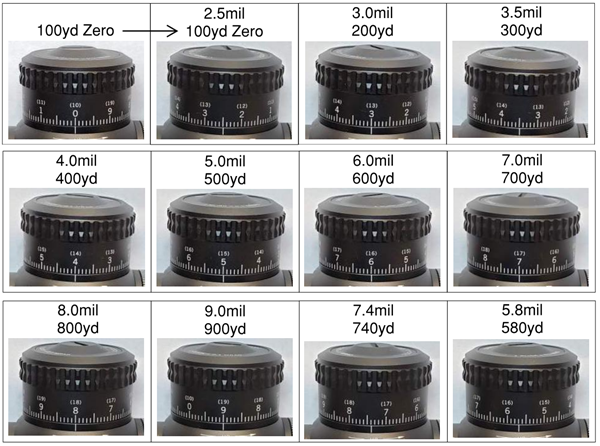
For either the BDC reticle or the BDC turret we will need to have some references for our closer targets. For this, I generally use 0.5 mils for 200 and 1.0 mill for 300 yards, it’s very close for most of the calibers I use. For the BDC system, my 100yds zero is a 2.5mil (my drop factor), 200yds is 3.0 mil, 300yds is 3.5 and at 400yds I can start to use the speed drop BDC reticle/turret with the yardage.
What about environmental changes? Yes, the environment will change our data, but is it enough change to matter at ranges mostly inside 800yards? Because this system already has some inherent errors that are likely larger than the environmental effects, the environmental effects can be ignored. If you would like to know more about how much the environment affects our data read this article: Understanding your Ballistics Calculator Atmospherics
The Speed Drop Factor is a useful thing to keep in your bag of tricks for when you need quick engagements. Although it is not a perfect system it will get you on target quickly with confidence and you only have to remember a couple of numbers.
What is your rifle’s Speed Drop Factor? How much error do you allow and what are your effective range limits?
Here are a couple of additional common-caliber examples.
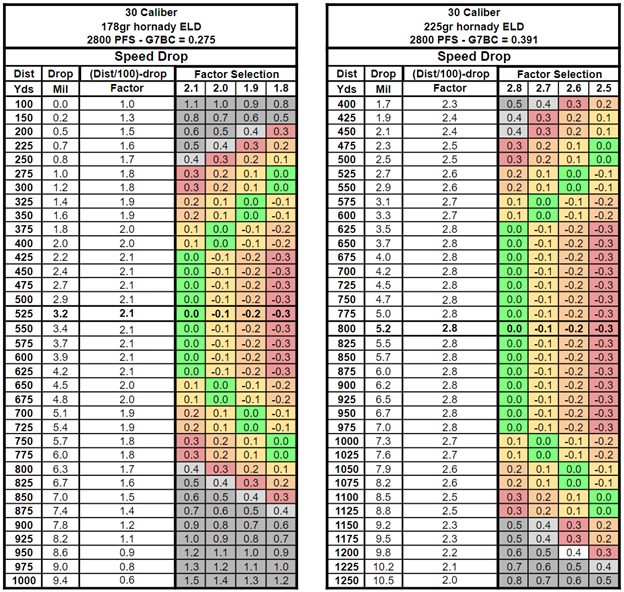
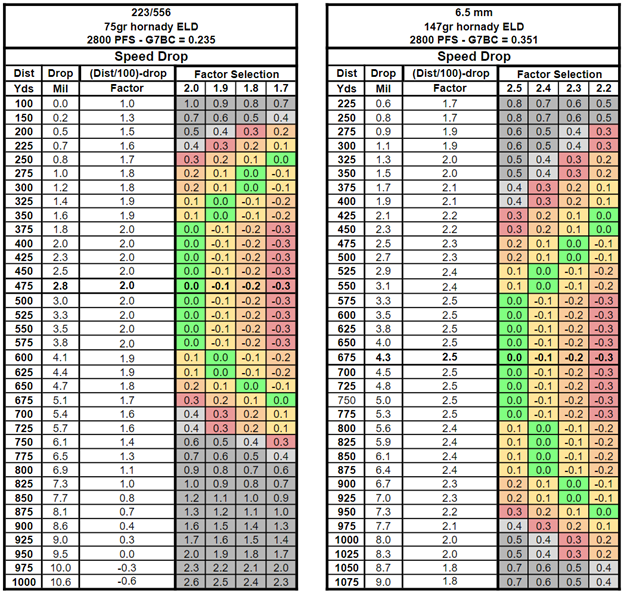
Ted Hoeger (Jack Master)

